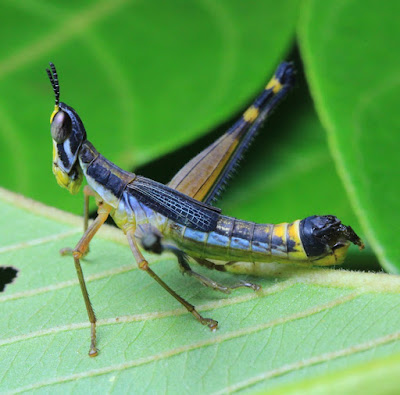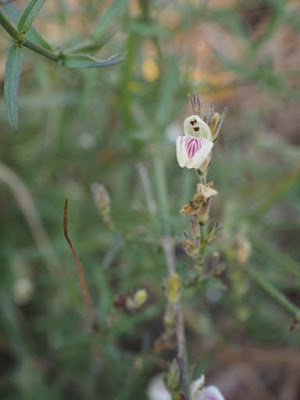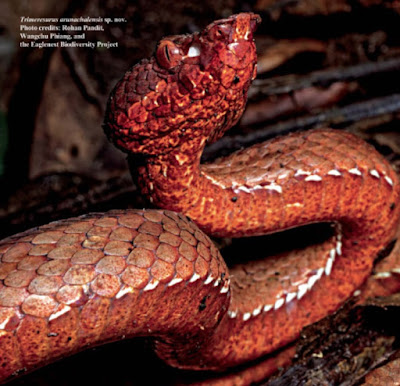[Most Recent Entries] [Calendar View]
Monday, May 6th, 2019
| Time | Event | ||||
| 7:06a | [Entomology • 2019] Review of Temnomastax Rehn & Rehn, 1942 (Orthoptera, Caelifera, Eumastacidae, Temnomastacinae)
Abstract Temnomastax is the commonest genus of monkey grasshoppers in the central region of South America. Herein the revision of this genus is presented. Three new species are described, Temnomastax descampsi Olivier sp. nov., Temnomastax monnei Olivier sp. nov., and Temnomastax otavioi Olivier sp. nov. Temnomastax chiquitos syn. nov. is proposed as a new synonym of Temnomastax borellii. Three morphological groups are proposed: the Beni group composed of Temnomastax beni; the Latens group composed of T. borellii, T. hamus, T. latens and T. monnei sp. nov.; and the Tigris group composed of T. descampsi sp. nov., T. otavioi sp. nov., T. ricardoi and T. tigris. Identification keys, biological and distribution data are provided. Keywords: Cerrado, eumastacids, morphology, taxonomy, Temnomastacini, Orthoptera Renan S. Olivier, Cristiane V.A. Pujol-Luz and Gustavo Graciolli. 2019. Review of Temnomastax Rehn & Rehn, 1942 (Orthoptera, Caelifera, Eumastacidae, Temnomastacinae). 4593(1); 1–78. DOI: 10.11646/zootaxa.4593.1.1 | ||||
| 9:09a | [Botany • 2019] Justicia cubangensis & J. eriniae (Acanthaceae) • Notes on Justicia sect. Monechma in Angola, including Two New Species
Abstract Two new species of Justicia sect. Monechma, Justicia cubangensis and J. eriniae, are described from Angola. Their affinities are reviewed, together with a discussion on the correct generic name to apply to these species. A conspectus of Justicia sect. Monechma ‘Group I’ in Angola is presented, including a key to the species and notes on habitat and distribution for each taxon. Two new combinations and one new name are provided for species for which there was no previous name available in Justicia, and lectotypes are proposed for four names. Twelve species are recognised in this group in total, eight of which are currently believed to be endemic to Angola. Justicia subsessilis is recorded in Angola for the first time, and J. laeta is placed in sect. Monechma, having previously been tentatively referred to sect. Tyloglossa. Monechma carrissoi is considered to be conspecific with J. virgultorum and so is synonymised here. In addition, the botanical importance of the type locality of J. cubangensis, the Cuchi River gorge of the Cubango drainage, is highlighted and two further new provincial records for Cuando Cubango are noted from this site: Eriocaulon angustibracteum (Eriocaulaceae) and Crepidorhopalon schweinfurthii (Linderniaceae). Keywords: Cuando Cubango; Huila; Namibe; justicioid; miombo; taxonomy Justicia cubangensis I.Darbysh. & Goyder, sp. nov. Etymology. The epithet ‘cubangensis’ denotes the Cubango River drainage in which this species is found. Justicia eriniae I.Darbysh., sp. nov. Etymology. The epithet ‘eriniae’ honours Dr. Erin Tripp of the Museum of Natural History (COLO Herbarium) at the University of Colorado, a leading authority on Acanthaceae, great all-round naturalist and collector of the type specimen of this species. Dr. Trip Darbyshire, I. and Goyder, D.J. 2019. Notes on Justicia sect. Monechma (Acanthaceae) in Angola, including Two New Species. Blumea - Biodiversity, Evolution and Biogeography of Plants. 64; 97–107. DOI: 10.3767/blumea.2019.64.02.01 | ||||
| 9:25a | [Entomology • 2019] Taxonomic Revision of the Genus Ponera Latreille, 1804 (Hymenoptera: Formicidae) of Taiwan and Japan, with A Key to East Asian Species
Abstract Ponera is a widespread genus of litter and soil ants. The highest diversity of the genus is found in Asia, with Taiwan and Japan being two of the most species-rich regions. Here, we systematically review the taxonomy of the 16 Taiwanese and Japanese Ponera species, two of which are new species from Taiwan: Ponera terayamai sp. n. and P. wui sp. n. A new key for Ponera species of East Asia is presented. Keywords: ant, Ponerinae, systematics, morphology, description, new species Chi-Man Leong, Benoit Guénard, Shiuh-Feng Shiao and Chung-Chi Lin. 2019. Taxonomic Revision of the Genus Ponera Latreille, 1804 (Hymenoptera: Formicidae) of Taiwan and Japan, with A Key to East Asian Species. Zootaxa. 4594(1); 1–86. DOI: 10.11646/zootaxa.4594.1.1 | ||||
| 12:15p | [Entomology • 2019] The Genus Mecodema Blanchard 1853 (Coleoptera: Carabidae: Broscini) from the North Island, New Zealand
Abstract Mecodema (Coleoptera: Carabidae: Broscini) is a hyperdiverse endemic New Zealand genus of ground beetles with only a few geographically widespread species found throughout the two main islands, as well as many offshore islands. Using specimens from a number of private and institutional collections, in addition new specimens were acquired by extensive pitfall trapping, we describe or redescribe all of the known North Island Mecodema species. Additionally, we redescribe three South Island species from the former genus Metaglymma, as morphological evidence shows that these species are nested within Mecodema. Species descriptions are formed by using 128 morphological characters, which include external characters, as well as both male and female internal structures. There are four new combinations: Mecodema antarctica comb. n., M. aberrans comb. n., M. moniliferum comb. n. and M. tibiale comb. n. We synonymise M. occiputale under Mecodema curvidens, and M. sulcatum under Mecodema oblongum, and reinstate M. scitulum Broun (northwest Hunua Range, Auckland). Twenty four new species are described: Mecodema argentum sp. n., M. atuanui sp. n., M. dunnorum sp. n., M. genesispotini sp. n., M. godzilla sp. n., M. jacinda sp. n., M. kipjac sp. n., M. kokoroiho sp. n., M. mohi sp. n., M. ngaiatonga sp. n., M. ngaitahuhu sp. n., M. papake sp. n., M. perexiguus sp. n., M. rusticulus sp. n., M. temata sp. n., M. teparawhau sp. n., M. teroroa sp. n., M. tewhara sp. n., M. tuhoe sp. n., M. undecimus sp. n., M. wharekahika sp. n., M. xylanthrax sp. n., M. yconomus sp. n., M. zonula sp. n. North Island regional species endemism is very high in Northland (15/16 endemic species), with species becoming more widespread in the southern regions, e.g. Wellington only has two endemic species from a total of eight species. This research increases the total number of described Mecodema species to 102, and will allow a modern taxonomic framework for completion of the revision of the South Island species. Keywords: Brullea, conservation, Diglymma, Metaglymma, Nothobroscina, Oregus, Orthoglymma, pitfall traps, Coleoptera David S. Seldon F.L.S. and Thomas R. Buckley. 2019. The Genus Mecodema Blanchard 1853 (Coleoptera: Carabidae: Broscini) from the North Island, New Zealand. Zootaxa. 4598(1); 1-148. DOI: 10.11646/zootaxa.4598.1.1 | ||||
| 12:45p | [Herpetology • 2019] Trimeresurus arunachalensis • A New Species of Pitviper (Serpentes: Viperidae: Trimeresurus Lacepède, 1804) from West Kameng District, Arunachal Pradesh, India
Abstract A new species of pitviper, Trimeresurus arunachalensis sp. nov., is described based on a single specimen. It differs from all known congeners by the following combination of characters — 19:17:15 acutely keeled dorsal scale rows (except first row — keeled or smooth); overall reddish-brown coloration; white dorsolateral stripe on outer posterior edges of ventrals and sometimes first dorsal scale row; 7 supralabials; 6 – 7 scales between supraoculars; 145 ventrals; 51 paired subcaudals (excluding the terminal scale); single anal; a sharply defined canthus rostralis with the margin overhanging the loreal region; a distinctly concave rostral scale with the upper edge projecting well beyond its lower margin; an unforked, attenuate hemipenis that extends to the 8th subcaudal scale, and has no visible spines. DNA phylogenetic analysis indicates that the new species is distinct from congeners and nested well within the Trimeresurus clade. The closest relative based on available DNA data is T. tibetanus. The new species is presently known from a single locality — Ramda, West Kameng, Arunachal Pradesh, northeastern India. Keywords: Crotalinae; snake; taxonomy; Trimeresurus arunachalensis sp. nov.; viper
Ashok Captain, V. Deepak, Rohan Pandit, Bharat Bhatt and Ramana Athreya. 2019. A New Species of Pitviper (Serpentes: Viperidae: Trimeresurus Lacepède, 1804) from West Kameng District, Arunachal Pradesh, India. Russian Journal of Herpetology. 26(2; 111-122. rjh.folium.ru/index.php/rjh/article/view/1 |
| << Previous Day |
2019/05/06 [Calendar] |
Next Day >> |














